- Back to Home »
- Strike wouldn't further Syria peace
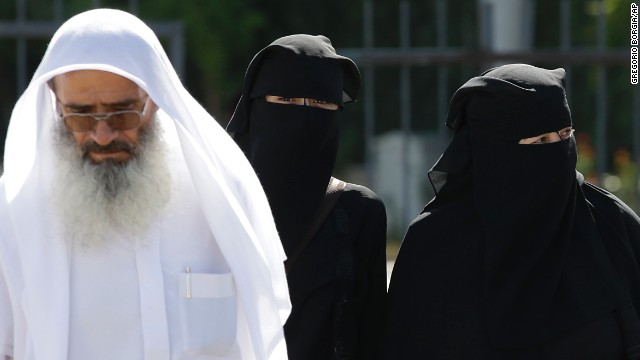 Syrian refugees arrive at the Turkish border gate of Cilvegozu on Thursday, September 5. The U.N. refugee agency said the number of Syrians who have fled their war-ravaged country has risen to more than 2 million.
Syrian refugees arrive at the Turkish border gate of Cilvegozu on Thursday, September 5. The U.N. refugee agency said the number of Syrians who have fled their war-ravaged country has risen to more than 2 million. 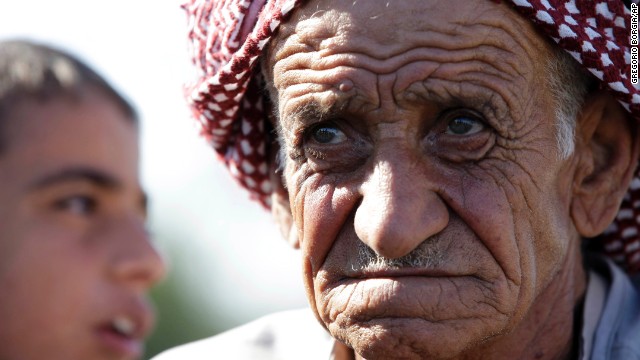 Syrian refugees gather in the village of Salkin after crossing the Syrian-Turkish border on September 5.
Syrian refugees gather in the village of Salkin after crossing the Syrian-Turkish border on September 5. 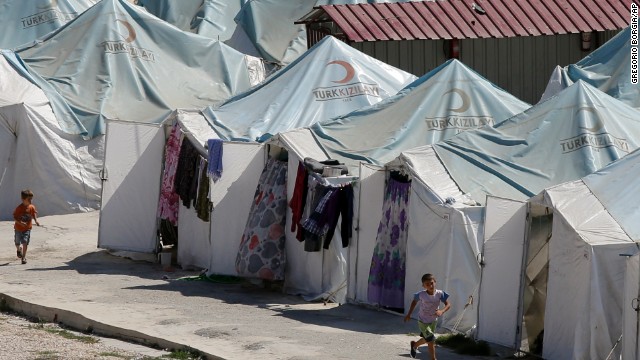 Children run past tents at a Syrian refugee camp in Yayladagi, Turkey, on September 3.
Children run past tents at a Syrian refugee camp in Yayladagi, Turkey, on September 3. 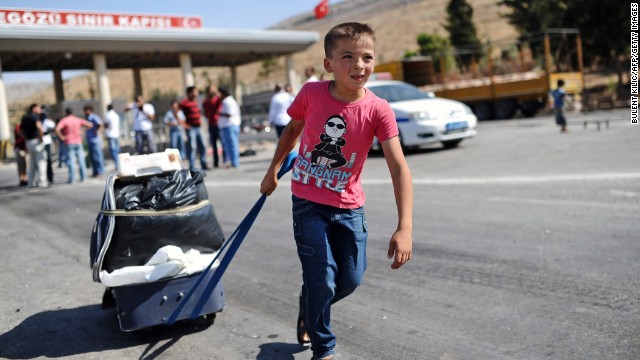 A child pulls a suitcase as Syrian refugees arrive at the Cilvegozu crossing gate of Reyhanli in Turkey's Hatay province on Saturday, August 31.
A child pulls a suitcase as Syrian refugees arrive at the Cilvegozu crossing gate of Reyhanli in Turkey's Hatay province on Saturday, August 31. 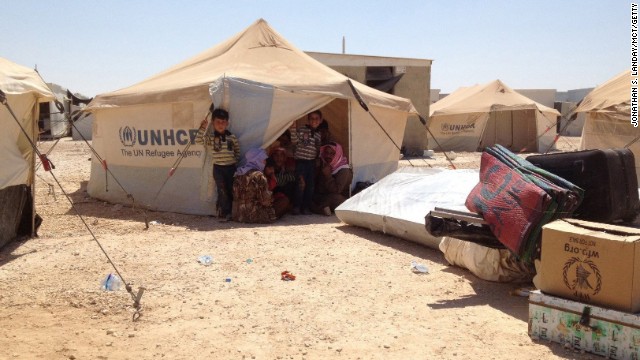 A family arrives from Syria at the Zaatari refugee camp in Jordan on Friday, August 30. Currently, Jordan has 515,000 registered Syrian refugees.
A family arrives from Syria at the Zaatari refugee camp in Jordan on Friday, August 30. Currently, Jordan has 515,000 registered Syrian refugees. 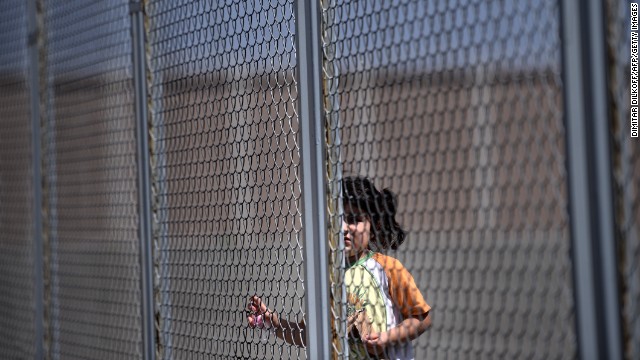 A Syrian girl stands behind a fence at Bulgaria's shelter near Lyubimets on August 28. More than 3,100 immigrants -- half of them Syrians -- have crossed into Bulgaria from neighboring Turkey this year, doubling their numbers compared with 2012 and and causing Bulgaria's few temporary accommodation facilities to overflow.
A Syrian girl stands behind a fence at Bulgaria's shelter near Lyubimets on August 28. More than 3,100 immigrants -- half of them Syrians -- have crossed into Bulgaria from neighboring Turkey this year, doubling their numbers compared with 2012 and and causing Bulgaria's few temporary accommodation facilities to overflow. 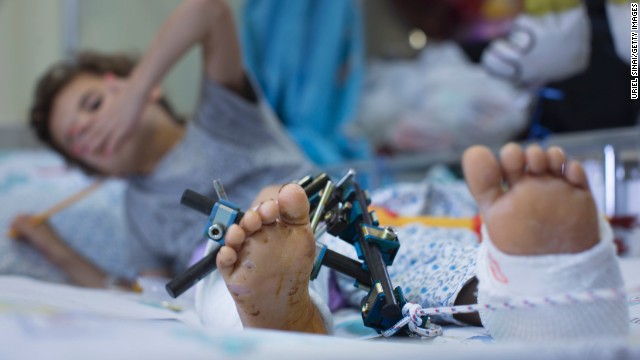 A wounded Syrian child is treated at the Israeli Ziv hospital on Wednesday, August 28, in the northern town of Safed, Israel. About 140 wounded Syrians, who have been fighting across the border from Israel, have been treated in Israeli hospitals since the beginning of the Syrian Civil war.
A wounded Syrian child is treated at the Israeli Ziv hospital on Wednesday, August 28, in the northern town of Safed, Israel. About 140 wounded Syrians, who have been fighting across the border from Israel, have been treated in Israeli hospitals since the beginning of the Syrian Civil war. 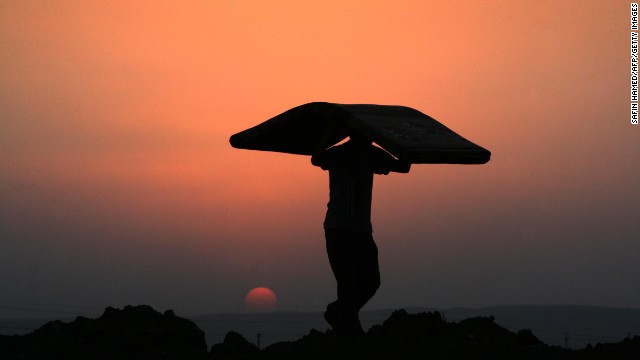 A Syrian-Kurdish man carries a mattress at sunset at the Quru Gusik refugee camp, east of Arbil, the capital of the autonomous Kurdish region of northern Iraq, on Tuesday, August 27. More than 50,000 Syrian refugees have crossed into Iraq's Kurdish region in less than two weeks as authorities rush to house them in more permanent camps.
A Syrian-Kurdish man carries a mattress at sunset at the Quru Gusik refugee camp, east of Arbil, the capital of the autonomous Kurdish region of northern Iraq, on Tuesday, August 27. More than 50,000 Syrian refugees have crossed into Iraq's Kurdish region in less than two weeks as authorities rush to house them in more permanent camps. 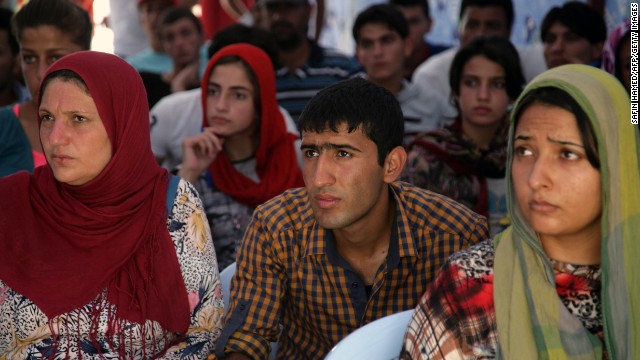 Syrian refugees listen to safety instructions at the Quru Gusik refugee camp on Saturday, August 24.
Syrian refugees listen to safety instructions at the Quru Gusik refugee camp on Saturday, August 24. 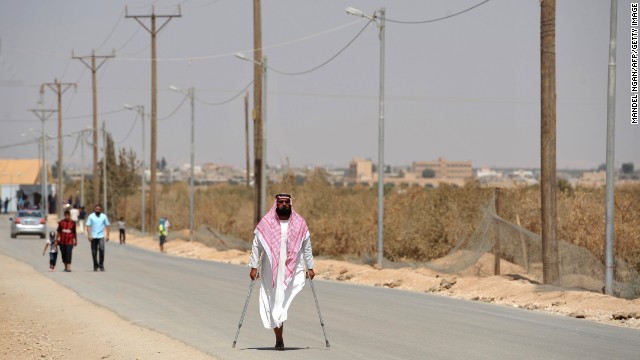 Syrian refugees at the Zaatari refugee camp on Thursday, July 18, near the Jordanian city of Mafraq, near the Jordanian-Syrian border.
Syrian refugees at the Zaatari refugee camp on Thursday, July 18, near the Jordanian city of Mafraq, near the Jordanian-Syrian border. 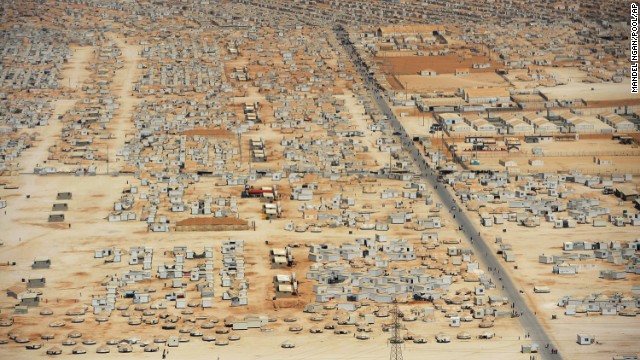 The expanse of the Zaatari refugee camp in Jordan as seen from an aerial view on July 18. The camp was opened on July 28, 2012, and is home to more than 130,000 refugees.
The expanse of the Zaatari refugee camp in Jordan as seen from an aerial view on July 18. The camp was opened on July 28, 2012, and is home to more than 130,000 refugees. 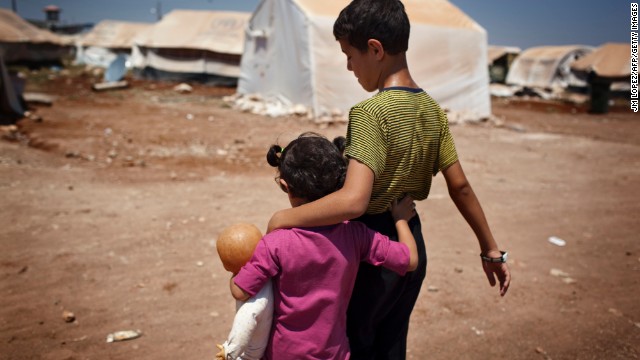 Syrian refugee children walk in the Bab al-Salam refugee camp in Syria's northern city of Azaz on Monday, July 15.
Syrian refugee children walk in the Bab al-Salam refugee camp in Syria's northern city of Azaz on Monday, July 15. 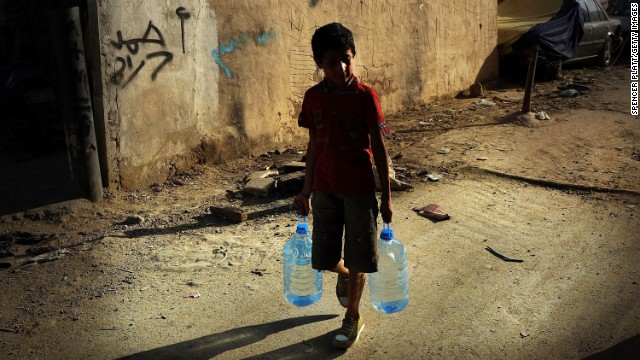 A boy walks with jugs of water on June 27 in a neighborhood in Beirut, Lebanon, with a high concentration of Syrian refugees. Since January, the number of Syrian refugees in Lebanon has more than tripled.
A boy walks with jugs of water on June 27 in a neighborhood in Beirut, Lebanon, with a high concentration of Syrian refugees. Since January, the number of Syrian refugees in Lebanon has more than tripled.  Syrian refugees stand with their belongings on June 20, World Refugee Day, at Zaatari refugee camp in Jordan.
Syrian refugees stand with their belongings on June 20, World Refugee Day, at Zaatari refugee camp in Jordan. 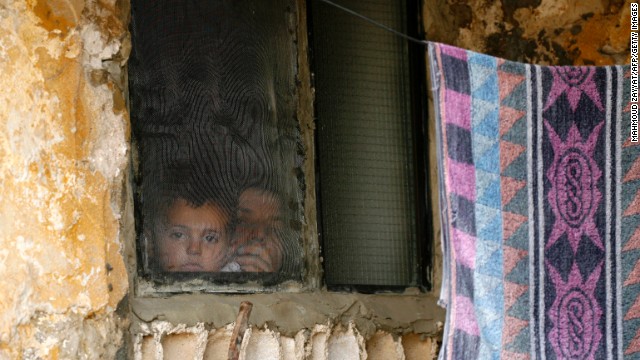 A Syrian woman and child look out of a refugee camp window on June 20 in Alman, Lebanon, after fleeing their hometown in Idlib province, Syria.
A Syrian woman and child look out of a refugee camp window on June 20 in Alman, Lebanon, after fleeing their hometown in Idlib province, Syria. 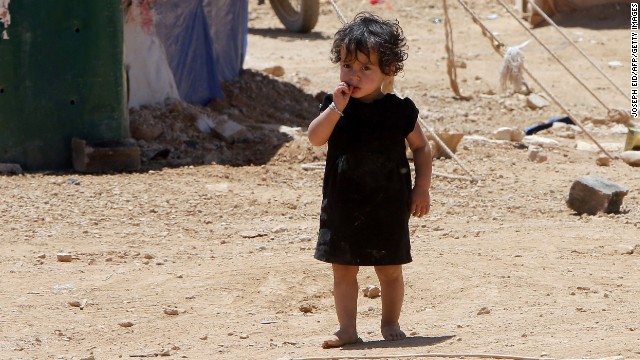 A child, whose family fled violence in Syria, stands at the Arsal refugee camp on June 14 in Lebanon's Bekaa Valley.
A child, whose family fled violence in Syria, stands at the Arsal refugee camp on June 14 in Lebanon's Bekaa Valley. 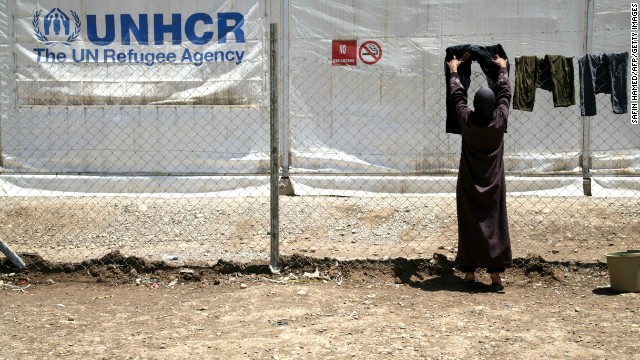 A woman uses a fence at the Domiz refugee camp near Kohuk, Iraq, to dry laundry on May 29.
A woman uses a fence at the Domiz refugee camp near Kohuk, Iraq, to dry laundry on May 29. 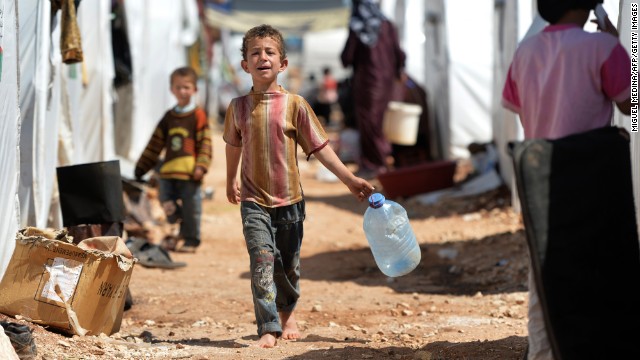 A boy carries a jug for water at the Maliber al-Salam refugee camp on April 28. The camp, located near the Turkish boarder, houses internally displaced Syrian families.
A boy carries a jug for water at the Maliber al-Salam refugee camp on April 28. The camp, located near the Turkish boarder, houses internally displaced Syrian families. 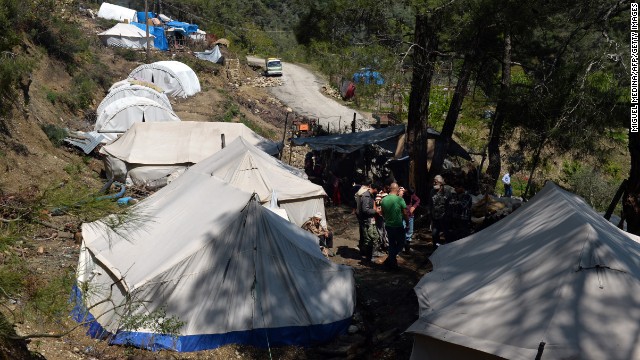 A makeshift refugee camp is seen near Syria's border with Turkey.
A makeshift refugee camp is seen near Syria's border with Turkey. 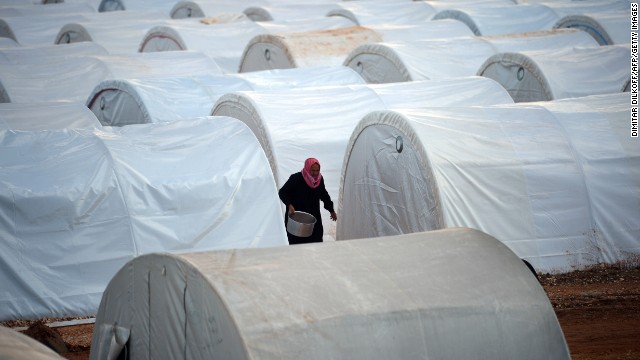 Row after row of temporary shelters fill the Maiber al-Salam refugee camp in Syria's Aleppo province, near the Turkish border on April 17.
Row after row of temporary shelters fill the Maiber al-Salam refugee camp in Syria's Aleppo province, near the Turkish border on April 17. 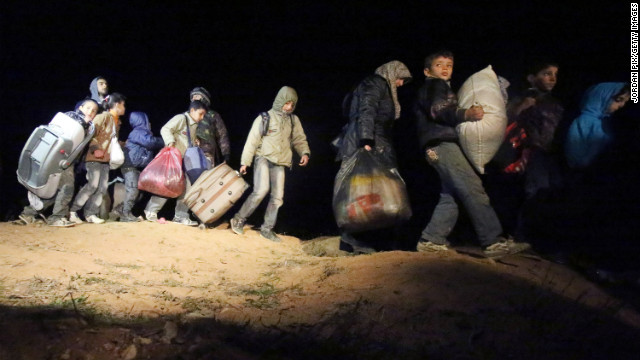 Refugees fleeing the conflict in Syria arrive February 18 at the Jordanian border.
Refugees fleeing the conflict in Syria arrive February 18 at the Jordanian border.  A Syrian girl stands at the entrance of a makeshift home near ruins in the ancient city of Serjilla in northwestern Syria on February 11. About half of Syria's refugees are children.
A Syrian girl stands at the entrance of a makeshift home near ruins in the ancient city of Serjilla in northwestern Syria on February 11. About half of Syria's refugees are children. 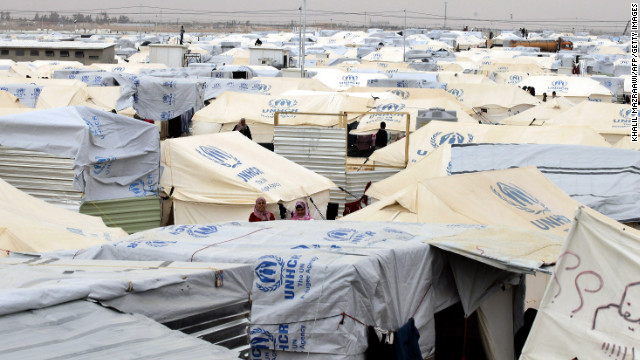 More than 400,000 people have fled Syria this year to countries including Lebanon, Jordan, Turkey, Iraq and Egypt. The Zaatari refugee camp is in Jordan, near the Syrian border.
More than 400,000 people have fled Syria this year to countries including Lebanon, Jordan, Turkey, Iraq and Egypt. The Zaatari refugee camp is in Jordan, near the Syrian border.  A refugee collects apples and some bread February 10 at the Azaz refugee camp along the Syrian-Turkish border. Turkey has spent more than $600 million setting up 17 refugee camps, with more under construction.
A refugee collects apples and some bread February 10 at the Azaz refugee camp along the Syrian-Turkish border. Turkey has spent more than $600 million setting up 17 refugee camps, with more under construction. 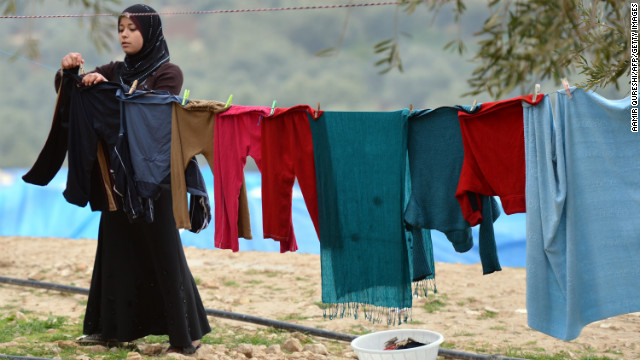 Clothes dry at the Qah refugee camp near the Turkish border on January 31. Many Syrians are forced to flee with few or no belongings.
Clothes dry at the Qah refugee camp near the Turkish border on January 31. Many Syrians are forced to flee with few or no belongings. 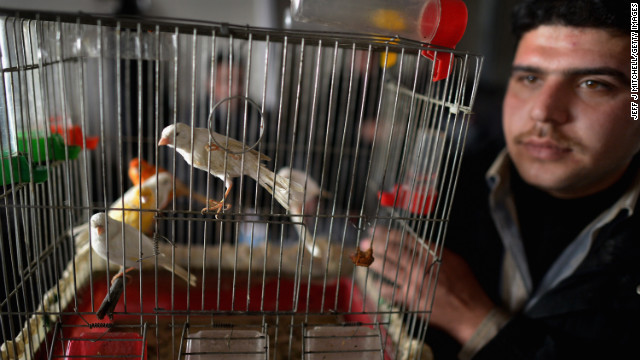 A man shows off his pet birds as new Syrian refugees arrive at the International Organization for Migration at the Zaatari refugee camp on January 30.
A man shows off his pet birds as new Syrian refugees arrive at the International Organization for Migration at the Zaatari refugee camp on January 30.  A refugee child gets a haircut at a makeshift barbershop at the Azaz refugee camp on February 19.
A refugee child gets a haircut at a makeshift barbershop at the Azaz refugee camp on February 19. 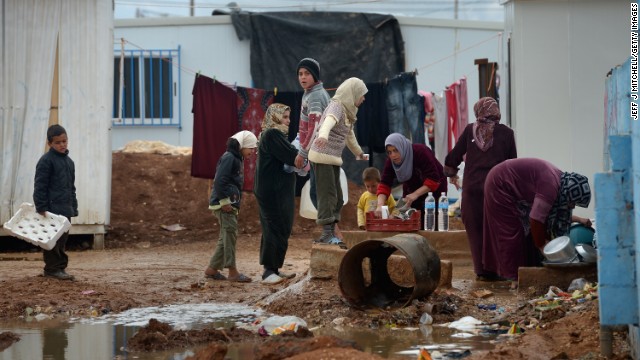 Syrian children gather around women washing in the Zaatari refugee camp on January 31.
Syrian children gather around women washing in the Zaatari refugee camp on January 31. 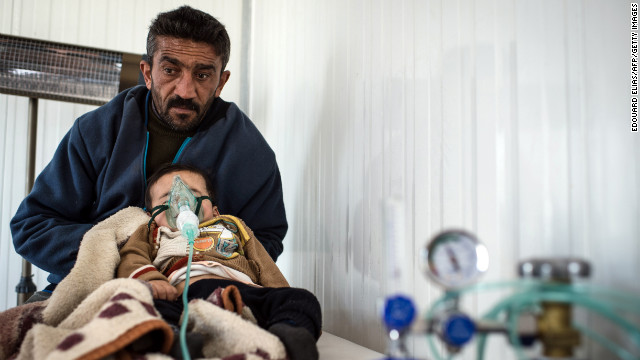 A refugee visits a clinic with his child at the Azaz refugee camp on February 10.
A refugee visits a clinic with his child at the Azaz refugee camp on February 10. 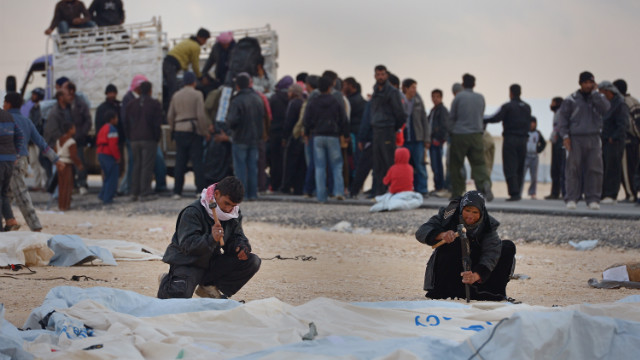 Syrians put up tents at the Zaatari refugee camp on January 30.
Syrians put up tents at the Zaatari refugee camp on January 30. 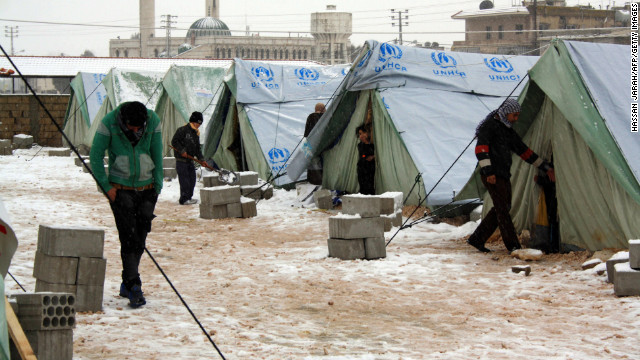 The U.N. High Commissioner for Refugees supplied tents in Al-Marj, in the eastern Lebanese Bekaa Valley. Some families have endured frigid weather in tent camps or struggle to pay for shelter.
The U.N. High Commissioner for Refugees supplied tents in Al-Marj, in the eastern Lebanese Bekaa Valley. Some families have endured frigid weather in tent camps or struggle to pay for shelter. 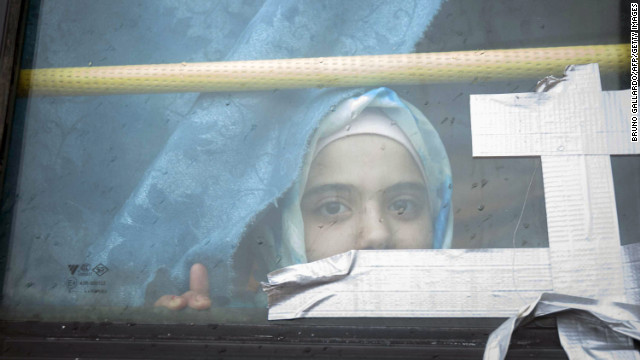 A Syrian girl looks through the window of a bus where she has lived with her family for the past eight months at a refugee camp in Bab al-Salam on the Syria-Turkey border on February 28.
A Syrian girl looks through the window of a bus where she has lived with her family for the past eight months at a refugee camp in Bab al-Salam on the Syria-Turkey border on February 28. 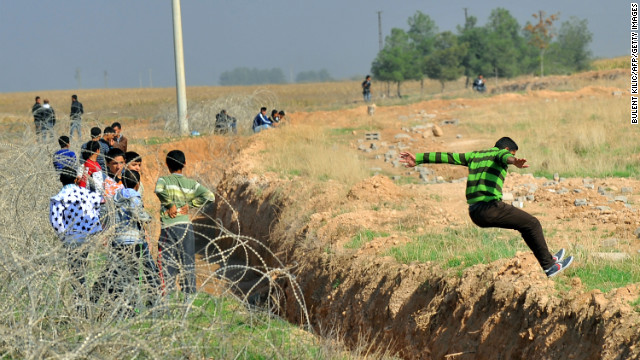 A Syrian jumps across the border between the Syrian town of Ras al-Ain and Ceylanpinar in Turkey's Sanliurfa province on November 10, 2012.
A Syrian jumps across the border between the Syrian town of Ras al-Ain and Ceylanpinar in Turkey's Sanliurfa province on November 10, 2012. 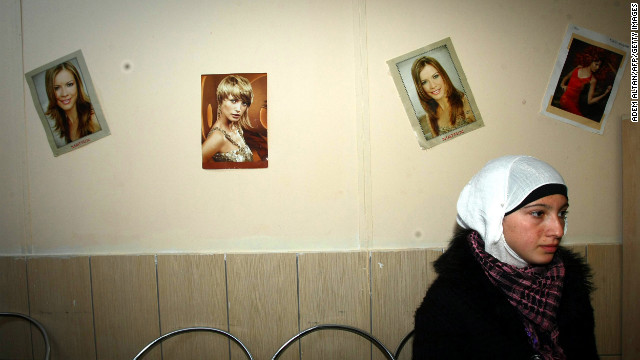 A Syrian refugee waits November 27, 2012, at a hairdresser's shop, where refugees can also receive training, inside the Oncupinar camp in Kilis, southern Turkey.
A Syrian refugee waits November 27, 2012, at a hairdresser's shop, where refugees can also receive training, inside the Oncupinar camp in Kilis, southern Turkey. 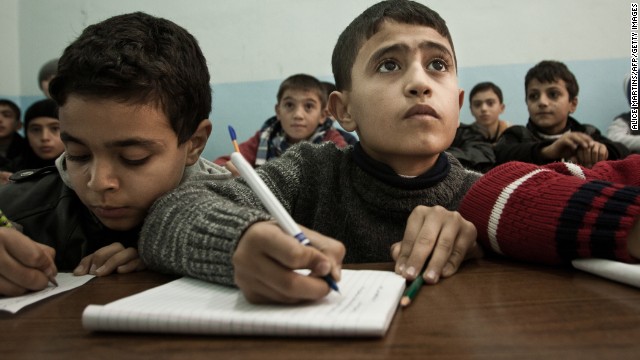 A Syrian boy attends school in the Turkish town of Kilis on December 17, 2012.
A Syrian boy attends school in the Turkish town of Kilis on December 17, 2012. 
1

2

3

4

5

6

7

8

9

10

11

12

13

14

15

16

17

18

19

20

21

22

23

24

25

26

27

28

29

30

31

32

33

34

35
- Patrick M. Regan: Obama facing decision on striking Syria over use of chemical weapons
- Whatever strategic reasons, he says, Obama's act would have implications for Syria's civil war
- He says much research shows outside intervention in civil wars makes them longer and worse
- Regan: Statistical evidence suggests well-timed negotiations can shorten war
Editor's note: Patrick M. Regan is a professor of peace studies and political science at the Kroc Institute for International Peace Studies, University of Notre Dame, who studies violent armed conflict and its resolution. He is the author of "Civil Wars and Foreign Powers" (University of Michigan Press, 2000) and "Sixteen Million One" (Paradigm, 2009), which examines the causes, consequences and possible solutions to civil wars.
(CNN) -- President Barack Obama faces a terrible choice in the coming days. It is whether to kill a number of Syrians who had nothing to do with a poison-gas massacre to show President Bashar al-Assad, who presumably did have something to do with it, that using chemicals weapons violates an international norm.
Few would doubt the importance of international agreements to regulate war, particularly those that safeguard the rights of citizens, such as bans on chemical weapons and torture. If al-Assad is responsible for the use of chemical weapons, he had full knowledge of the norms he was violating.
By way of comparison, President George W. Bush chose a policy that allowed torture in interrogations with full knowledge that it was outlawed by agreements to which the United States was a signatory. He made a strategic choice in the face of a threat to national security. Both are abhorrent actions on the part of national leaders, both taken for fundamentally the same reasons.

An attack on the Syrian military by the United States would send a message to al-Assad, but it is not clear if Obama has any strategic objective beyond that. Whether he has such a plan or not, any U.S. attack will have implications for the civil war, no matter how much Obama says otherwise.
If the United States launches missiles into Syria, those cheering the loudest will be the Syrian rebels. The United States will be intervening in the Syrian civil war on behalf of the rebels. A significant amount of research, including my own, demonstrates that military interventions from outside states lengthen and make bloodier civil wars. Much of this evidence is the result of statistical modeling of all civil wars and any associated interventions. The data include roughly 1,000 interventions into 100 civil wars over the last 60 years, with research carried out by multiple research teams.
The results point to patterns in what happens when states intervene to try to help their preferred actor, and the results are strong and consistent that interventions rarely work to promote peace or reduce violence. For example, my own research has shown that the likelihood of a civil war lasting for four years without an intervention is 37%, but if there is an intervention the likelihood that it lasts for four years is 60%. The intervention accounts for the 50% increase in the length of the war.
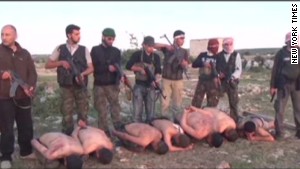 Syrian rebels film execution
Syrian rebels film execution  Gingrich: 'This is an act of war'
Gingrich: 'This is an act of war' 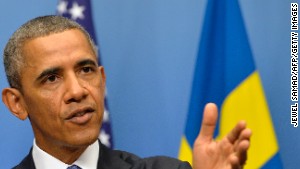 Obama reframes 'red line'
Obama reframes 'red line' Longer wars are generally bloodier. Examples might include the Nicaraguan war in the 1980s, and the Syrian war up to this point. The meager support for the rebels has allowed them to push harder against the government, and whether or not we support the government, the killing and the war's duration has only increased.
It's hard to predict exactly what will happen, of course, but once the United States bombs Syrian forces, it is possible that the rebels will take that moment to launch their own offensive, forcing the Syrian government to respond even more resolutely, greatly worsening the bloodshed.
Even if a U.S. missile strike reflects inadvertent help for the rebels, history does not point to a good outcome for U.S. policy.
The only pathway by which external interventions consistently make for shorter or less bloody wars is through diplomatic efforts to broker a peace agreement. The same modeling evidence suggests that the war in Angola, 1975-1991, could have been shortened by nearly 10 years with well-timed diplomatic interventions.
From this perspective, a missile strike will only move the situation further from peace. Sometimes the difficulty for warring parties to come to a negotiating table is tied up in information that is held private, the very thing that mediators can manage. So why not engage in serious diplomacy?
The United States has two stated policies, at least beyond the immediate question of punitive bombing in response to the chemical attacks. The first is to aid the Syrian opposition in its fight against the Assad regime; the second is to help broker a negotiated settlement.
The second goal makes sense; the first is fraught with difficulties. Two aspects of the negotiated route pose a problem for the United States. First, the official U.S. policy is that al-Assad must go. Both former Secretary of State Hillary Clinton and Secretary of State John Kerry have made these claims. Second, the rebels have steadfastly refused to negotiate. The only policy on the table is to kill more Syrians to show the Syrian leaders that killing Syrians is wrong. In this regard, U.S. policies are inconsistent with past behavior, empirical evidence and logic.
Follow us on Twitter @CNNOpinion.
Join us on Facebook/CNNOpinion.
The opinions expressed in this commentary are solely those of Patrick M. Regan.







